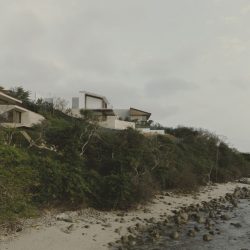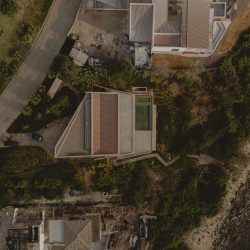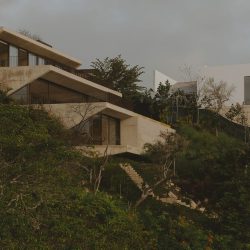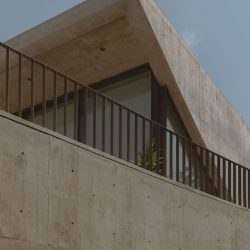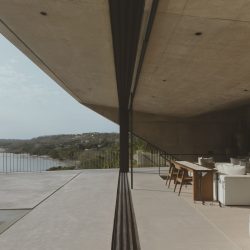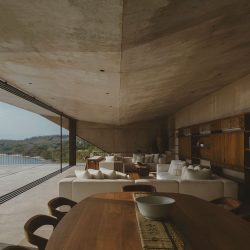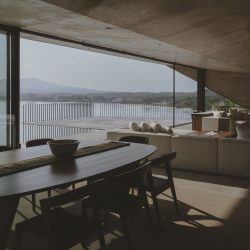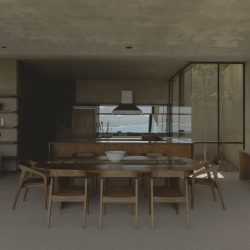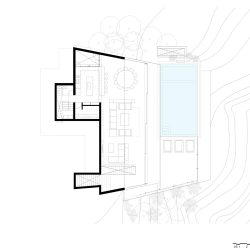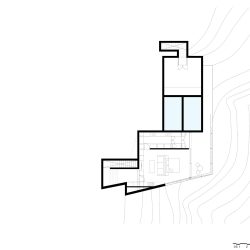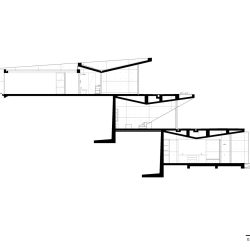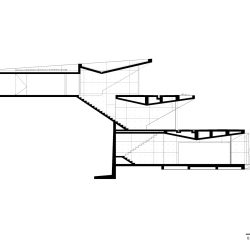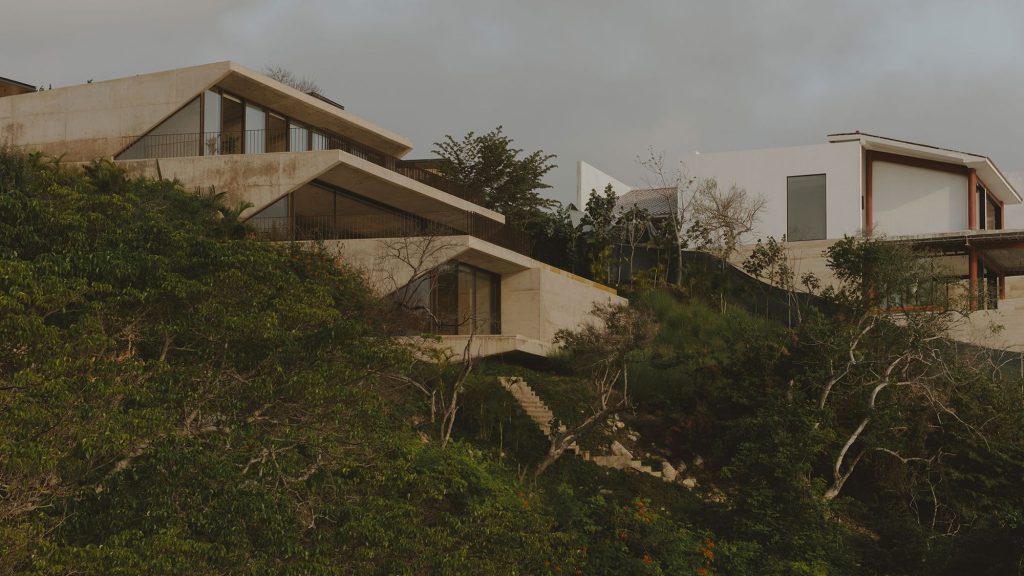
Módica Ledezma . JJRR . photos: © Zaickz Moz
Iyari is a 564 sqm single-family home project located in Punta Mita, Nayarit (Mexico), designed by the Módica Ledezma office in collaboration with JJRR to respond to a peculiar topography and address the different senses that make up its experience. Visually, it seeks to make the most of the privileged view of the sea, so the design focused on generating a structure that would interfere as little as possible with this sensorial relationship.
It is located on a very steep slope, so it was decided to develop it in three levels that unfold like a fan in sections, responding to the natural unevenness and generating a structure of habitable spaces. This approach resulted in a concise project in terms of its intentions, structure and materiality, displaying a legible architectural program where the different areas are separated by levels that open to the ocean.
The project seeks adaptability, and although the sculptural factor that composes it is undeniable, it intends to merge as much as possible with the mountain that houses it.
The footprint allowed for the construction was very limited in relation to the objectives of the architectural program. However, it was possible to incorporate an extensive list of spaces that meet the basic needs of its inhabitants, in addition to creating gardens that visually end at different points, seeking spatial democracy and providing each room with a unique experience. A staircase connects with the social area, where an attempt is made to expand the footprint of what was built towards a terrace with a large clearing, containing on one side the services grouped into the kitchen, laundry, bathrooms, etc., which are ventilated and illuminated naturally by a patio.
Towards the outside, we have a platform with a terrace, a pool and an open-air terrace space. The relationship between the short span of the house and the last point of the terrace is very close. This cave-like morphology maximizes the spatial sensation between the interior and the exterior, a constant aspect in our searches, although it is not the final result.
This is a very practical project that stands out more for the sensation of spaciousness than for its large size, achieved by means of structures that allow a view to be opened towards the Pacific. The spatial sensation is one of great freedom, despite the heaviness of the exposed concrete and the very marked line shapes. What steals the show is the sensation of openness towards the views, present in practically all the habitable spaces of the project. This is what was sought with spatial democracy: although the program privileges the main bedroom for its scale, all the spaces have equal circumstances. The size of each of the rooms is a secondary consequence of the possibility of playing with a containment structure, formed by the three levels. This containment structure becomes a habitable, covered bridge with a terrace on the next level. It is a very simple equation that, with very concrete actions, allows the objective to be achieved: the experience of a beach house.
The development in the area encourages low impact, delimited by a polygonal, which means that the restrictions are very defined. The logic is to minimize the impact and avoid very prominent volumes when there are uneven ground.
Upon entering, you are greeted by the sculpture of the concrete volumes, inviting you to the final view: when you open the door, the sea opens up. To the left, there is the volume of rooms and, going down, you find the complete social area, with its services a little further back.
The structure of the beam with the inclined roof was designed to bridge an important gap. The volumes without direct access to windows have a patio for ventilation and lighting, avoiding the cave effect. From the kitchen, there is a view of the sea. The rooms are discreet and simple volumes, a response to the limited footprint available. The main room, on a lower level, has a larger scale and lives within these diagonal structures. The wall that becomes a beam avoids the tunnel effect of vision, offering a 180-degree opening. This technical gesture was designed to imitate the vegetation, avoiding the rooms feeling closed in. The house is buried, inviting the lateral vegetation and the descending slope.
The sculptural gestures were not the objective, but rather the result of the adaptation to the topography. The house is clear in its layout: containment structures that became habitable mouths to take advantage of the descending topography. There are no labyrinths, as the house is compressed into this topographic accordion.
_
Iyari es un proyecto de vivienda unifamiliar de 564 m² ubicado en Punta Mita, Nayarit (México), diseñado por la oficina Módica Ledezma en colaboración con JJRR para responder a una peculiar topografía y atender los distintos sentidos que conforman su vivencia. Visualmente, busca aprovechar al máximo la privilegiada vista al mar, por lo que el proceso de diseño se enfocó en generar una estructura que interviniera lo menos posible con esta relación sensorial. Se encuentra en un terreno con una pendiente muy pronunciada, por lo que se optó por desarrollarlo en tres niveles que se despliegan como un abanico en sección, respondiendo a los desniveles naturales y generando una estructura de claros habitables. Este enfoque resultó en un proyecto muy conciso en cuanto a sus intenciones, estructura y materialidad, desplegando un programa arquitectónico legible donde se separan las distintas áreas mediante niveles que se abren al océano. El proyecto busca la adaptabilidad, y aunque es innegable el factor escultórico que lo compone, su intención es fundirse lo más posible con la montaña que lo alberga. La huella permitida para la construcción era muy limitada en relación con los objetivos del programa arquitectónico. Sin embargo, se logró incorporar una lista extensa de espacios que atienden las necesidades básicas de sus habitantes, además de crear jardines que rematan visualmente en distintos puntos, buscando la democracia espacial y proporcionando a cada habitación una experiencia única. Una escalera conecta con el área social, donde se procura ampliar la huella de lo construido hacia una terraza con un gran claro, conteniendo por un costado los servicios agrupados en cocina, lavandería, baños, etc., que se ventilan e iluminan de forma natural mediante un patio. Hacia el exterior, tenemos una plataforma con una terraza, una alberca y un espacio de terraza a cielo abierto. La relación entre el claro corto de la casa y el último punto de la terraza es muy cercana. Esta morfología de cueva maximiza la sensación espacial entre el interior y el exterior, un aspecto constante en nuestras búsquedas, aunque no es el resultado final. Se trata de un proyecto muy práctico que destaca más por la sensación de amplitud que por su gran tamaño, lograda mediante estructuras que permiten abrir un visor hacia el Pacífico. La sensación espacial es de gran libertad, a pesar de la pesadez del concreto aparente y las formas de líneas muy marcadas. Lo que se roba el espectáculo es la sensación de apertura hacia las vistas, presente en prácticamente todos los espacios habitables del proyecto.Esto es lo que se buscaba con la democracia espacial: aunque el programa privilegia la recámara principal por su escala, todos los espacios tienen igualdad de circunstancias. El tamaño de cada uno de los cuartos es una consecuencia secundaria de la posibilidad de jugar con una estructura de contención, formada por los tres niveles. Esta estructura de contención se convierte en un puente habitable, cubierto y con terraza en el siguiente nivel. Es una ecuación muy simple que, con acciones muy concretas permite alcanzar el objetivo:la vivencia de una casa de playa. El desarrollo en el área incentiva el bajo impacto, delimitado por una poligonal, lo que significa que las restricciones están muy definidas. La lógica es minimizar el impacto y evitar volúmenes muy prominentes cuando hay desniveles. Al entrar, te recibe la escultura de los volúmenes de concreto, invitándote a la vista final: al abrir la puerta, se abre el mar. A la izquierda, está el volumen de habitaciones y, al bajar, se encuentra el área social completa, con sus servicios un poco más atrás. La estructura de la trabe con el techo inclinado se diseñó para salvar un claro importante. Los volúmenes sin acceso directo a ventanas tienen un patio para ventilación e iluminación, evitando el efecto de cueva. Desde la cocina, hay vista al mar. Las habitaciones son volúmenes discretos y sencillos, una respuesta a la limitada huella disponible. La habitación principal, en un nivel inferior, tiene una escala mayor y vive dentro de estas estructuras diagonales. El muro que se convierte en trabe evita el efecto túnel de visión, ofreciendo una apertura de 180 grados. Este gesto técnico se diseñó para imitar a la vegetación, evitando que los cuartos se sintieran cerrados. La casa se va enterrando, invitando a la vegetación lateral y a la ladera descendente. Los gestos escultóricos no fueron el objetivo, sino la resultante de la adaptación a la topografía. La casa es clara en su diagrama: estructuras de contención que se convirtieron en bocas habitables para aprovechar la topografía descendente. No hay laberintos, ya que la casa se comprime en este acordeón topográfico.

